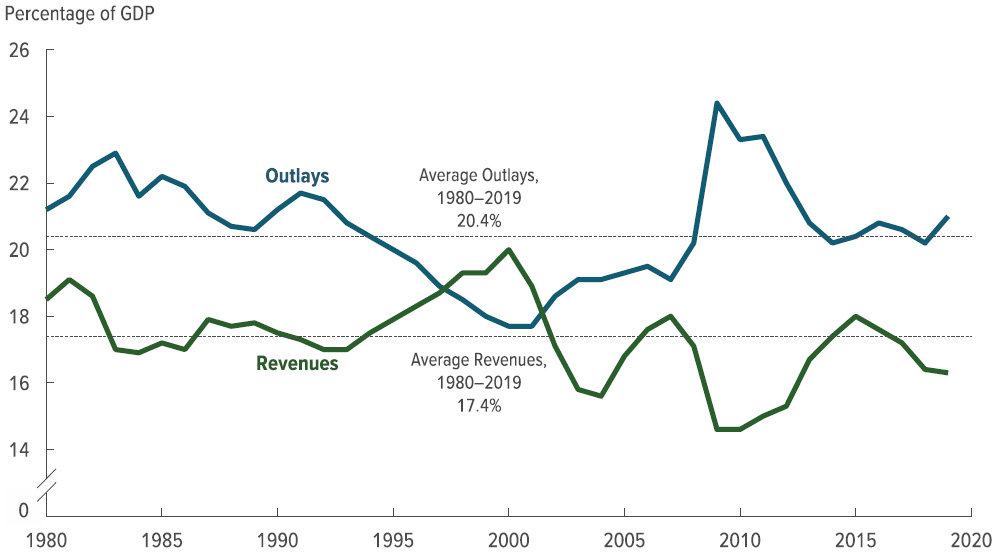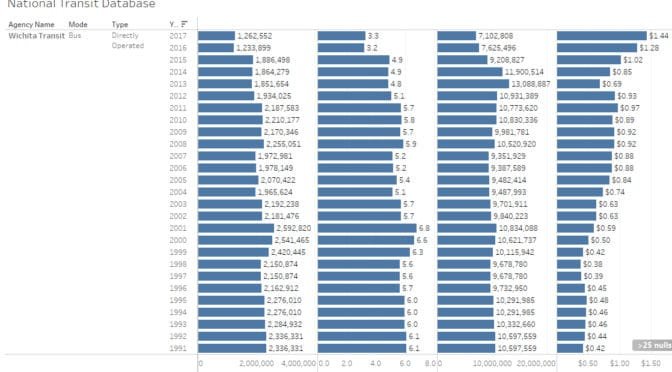Data from the annual report for the 2018-2019 school year for USD 259, the Wichita, Kansas public school district.
The Comprehensive Annual Financial Report for USD 259, the Wichita public school district, provides a look at trends over the years. The document, along with those from previous years, is available here. Here are some highlights from the CAFR for the year ending June 30, 2019, known as fiscal year 2019. The CAFR was released in December 2019.
(Click charts for larger versions.)
The following chart shows data from the CAFR along with my calculations. I took two data series, “total revenue” and “sum of state and local revenue,” then divided by FTE enrollment and adjusted for inflation. (The inflation adjustments cast past dollar values in terms of current-dollar equivalents, meaning past values are usually reduced.) I plot the sum of state and local revenue because in 2015 there was a change in the way some taxes were allocated. Plotting the sum of the two removes the effect of the change.
While USD 259 — and schools generally — complain about funding cuts, the following chart shows funding nearly always increases, and over time, by quite a bit.
The following chart shows spending categorized by “instruction” and “instructional support” per student in inflation-adjusted dollars. Capital spending is not included in this chart.
In 2006, USD 259 spent $571 per student (inflation-adjusted) on administration. For 2019 the figure is $904. Could the Wichita public school district cut administration spending to 2006 levels, on a per-student, inflation-adjusted basis?
The Wichita school district has been able to reduce its student/teacher ratios substantially over the last ten to fifteen years. (Student/teacher ratio is not the same statistic as class size.) There have been ups and downs along the way, but for all three school levels, the ratios are lower than they were years ago, and by substantial margins. This means that Wichita schools have been able to increase the employment of teachers at a faster rate than enrollment has risen.
On enrollment, the superintendent’s letter says this:
Budget reduction measures, stagnant population growth and changes to Kindergarten funding at the state level have all contributed to a decreasing enrollment trend which began in FY’16. Enrollment losses have primarily been at the elementary level. Those losses have been somewhat offset by increases in secondary enrollment, virtual and alternative programs. The elementary enrollment decline continued into FY’20, with a decrease of almost 800 elementary students. Once again, secondary enrollment offset some of this loss, increasing more than 350 students. The declines in past few years can partially be attributed to cost-cutting measures under the block grant, including denial of out-of-district students, the consolidation of alternative high school programs, and the combination of a longer school day and shorter school year, which many parents viewed as negatively impacting their students. Further, now that the State fully funds all-day Kindergarten, parents who used to enroll students in the District to obtain all-day Kindergarten services can now receive those same services in the surrounding area districts. Additional FY’19 funding allowed the District to return to the longer school year, but that action did not bring back elementary students to the District for FY’ZO. The District has instituted several promotion and program initiatives to attract students to the District, but it remains unclear if this will be continuing trend in the years to come.
In the previous year’s report, there was this commentary on enrollment:
The District’s enrollment trend over the last ten years has reflected an average increase of over 100 students a year. However, budget reduction measures and changes to Kindergarten funding at the state level are beginning to impact this trend. In FY’17, official enrollment decreased by 572 students, or one percent. Official enrollment in FY’18 increased by 80 students, but gains in virtual and alternative programs were offset by a significant decrease in elementary age students. The elementary enrollment decline continued into FY’19, with a loss of over 500 elementary students. Offsetting some of this loss, Secondary enrollment increased by 240 students. The declines in past few years can partially be attributed to cost-cutting measures under the block grant, including denial of out-of-district students, the consolidation of alternative high school programs, and the combination of a longer school day and shorter school year, which many parents viewed as negatively impacting their students. Further, now that the State fully funds all-day Kindergarten, parent who used to enroll students in the District to obtain all-day Kindergarten services can now receive those same services in the surrounding area districts. Additional FY’19 funding allowed the District to return to the longer school year, but it remains unclear if this action will bring back elementary students to the District.’
Since 2015, Kansas test scores have been reported in a new way. Kansas State Department of Education explains:
Kansas assessment results are now reported in four levels. Level 1 indicates that a student shows a limited ability to understand and use the mathematics skills and knowledge needed for college and career readiness. Level 2 indicates that a student shows a basic ability to understand and use the mathematics skills and knowledge needed for college and career readiness. Level 3 indicates that a student shows an effective ability to understand and use the mathematics skills and knowledge needed for college and career readiness. Level 4 indicates that a student shows an excellent ability to understand and use the mathematics skills and knowledge needed for college and career readiness.
For Wichita, the trend is that an increasing proportion of students are at performance level 1 until this year when the percent at performance level 1 fell to 46.1 percent from 47.0 percent.
Following, a chart of the portion of Wichita public school students testing at performance level 1, the lowest level.
Following, for performance level 2 or better, indicating, “a student shows a basic ability to understand and use the mathematics skills and knowledge needed for college and career readiness.” The percent at performance level 2 or better rose from 34.4 percent last year to 35.9 percent this year.
Following, for performance level 3 or better, indicating, “a student shows an effective ability to understand and use the mathematics skills and knowledge needed for college and career readiness.” The percent at this level fell to 13.7 percent from 14.3 percent the previous year.
Following, for performance level 4, indicating, “a student shows an excellent ability to understand and use the mathematics skills and knowledge needed for college and career readiness.” The percent at this level rose to 4.4 percent from 4.2 percent the previous year.
Following, charts of suspensions and expulsions.



































